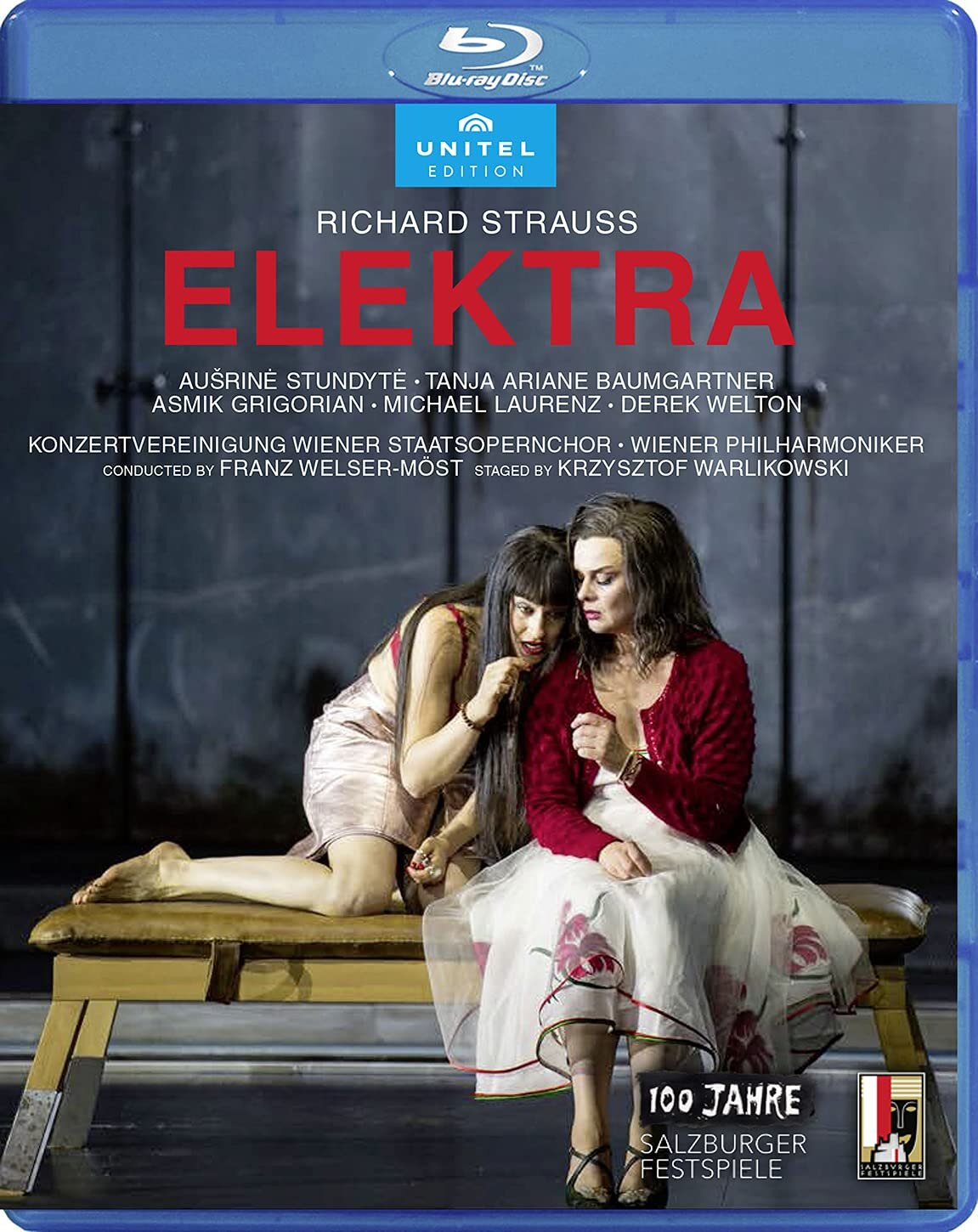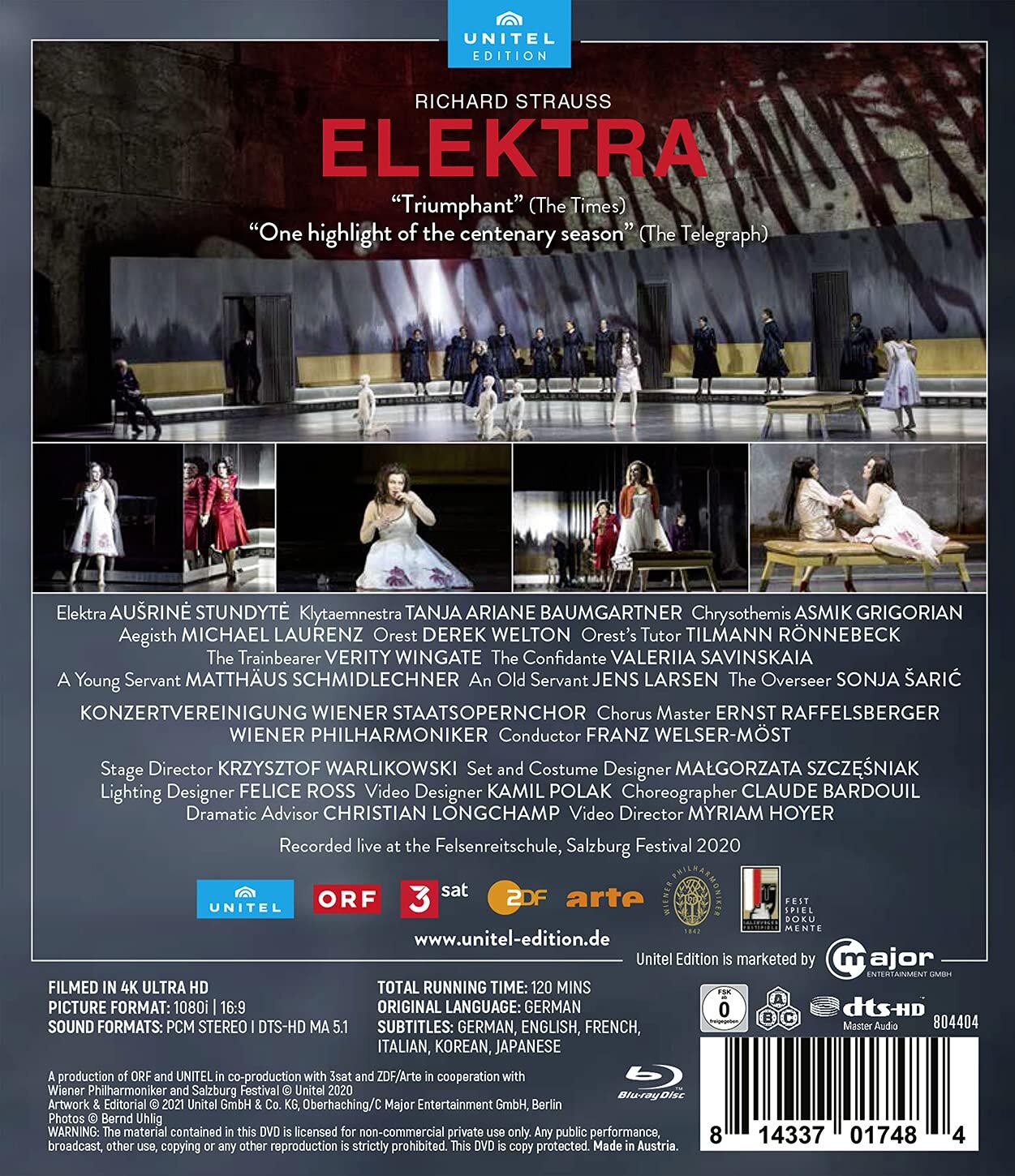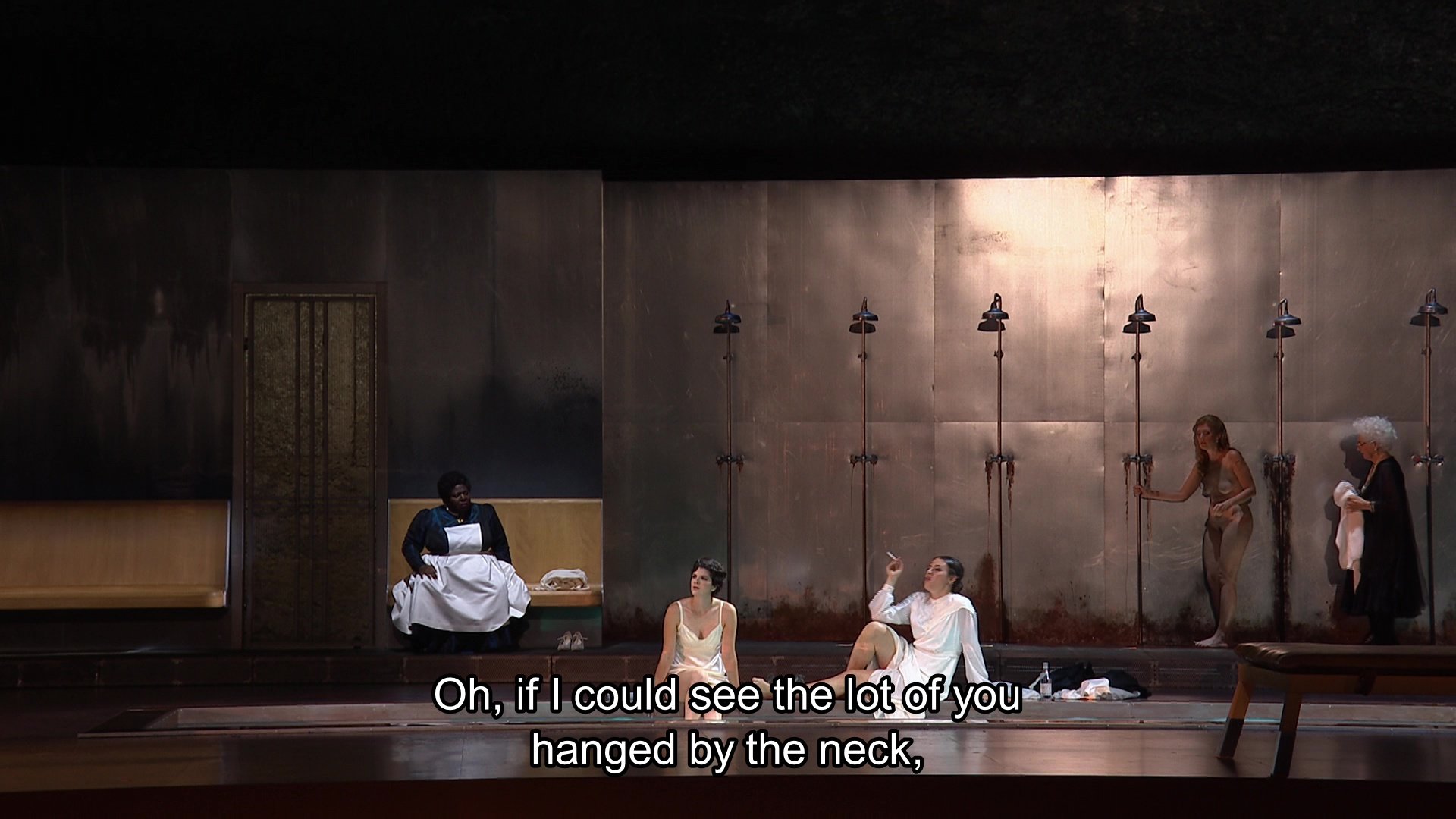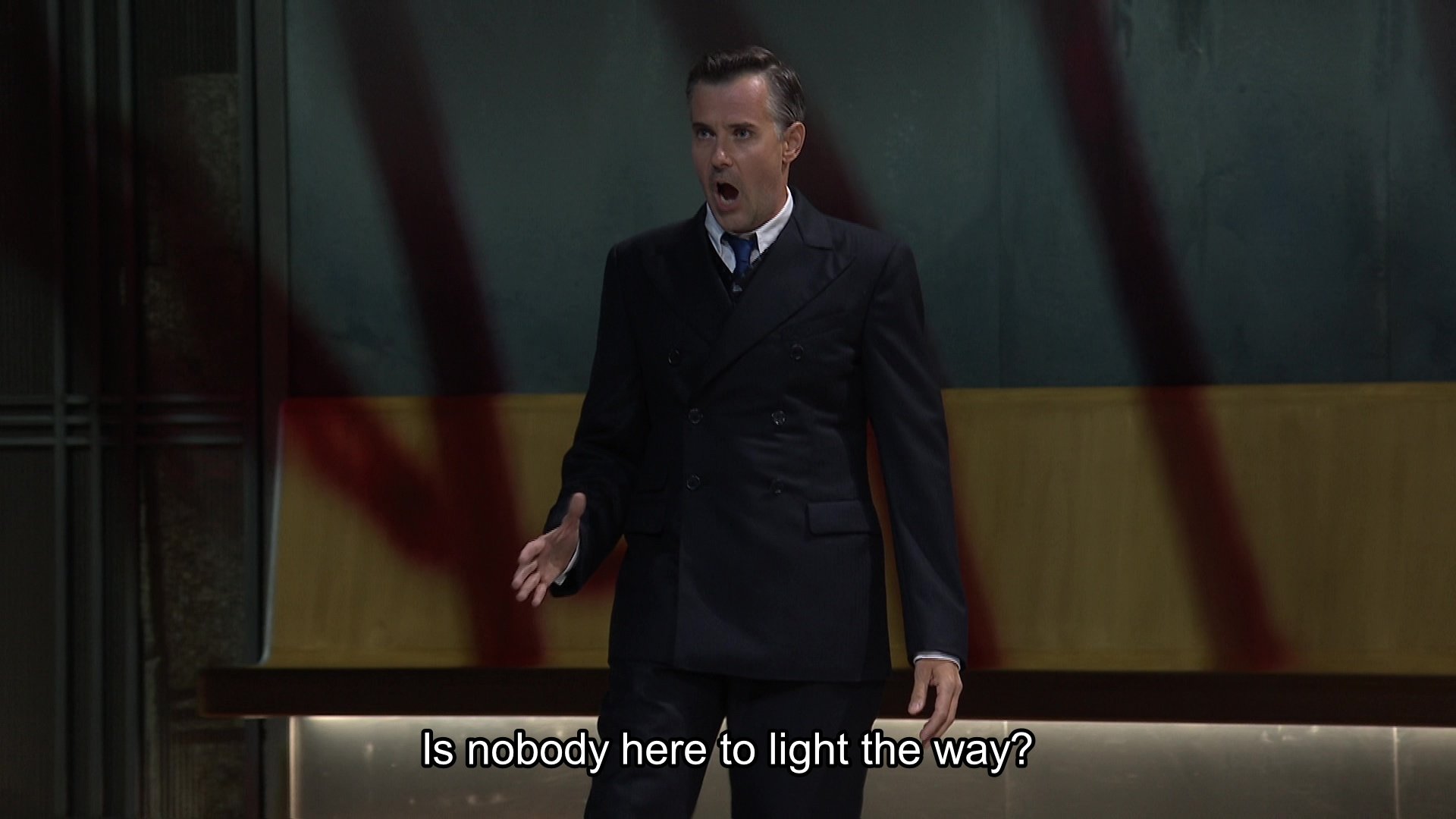

Richard Strauss Elektra opera to a libretto by Hugo von Hofmannsthal. Directed 2020 by Krzysztof Warlikowski at the Felsenreitschule as part of the Salzburg Festival. Stars Aušrinė Stundytė (Elektra), Tanja Ariane Baumgartner (Klytaemnestra), Asmik Grigorian (Chrysothemis), Michael Laurenz (Aegisth), Derek Welton (Orest), Tilmann Rönnebeck (Orest’s Tutor), Verity Wingate (The Trainbearer), Valeriia Savinskaia (The Confidante), Matthäus Schmidlechner (A Young Servant), Jens Larsen (An Old Servant), and Sonja Šarić (The Overseer). Franz Welser-Möst conducts the Wiener Philharmoniker and the Konzertvereinigung Wiener Staatsopernchor (Chorus Master Ernst Raffelsberger). Set and costume design by Małgorzata Szczęśniak; lighting design by Felice Ross; video design by Kamil Polak; choreography by Claude Bardouil; dramatic adviser was Christian Longchamp. Directed for TV by Myriam Hoyer. Sung in German. Released 2021, disc has 5.1 dts-HD Master Audio sound. Grade: B
It’s summer 2020 during the pandemic. We are at the horrible Felsenriteschule stage for a Salzburg Festival opera. The director for Elektra is eurotrashmaster Krzysztof Warlikowski. No curtain, no fly, no turntable—it’s like being outside except you are in a cave. Since this was a stable for horses, it has plumbing. So there can be a water feature. This works well for Elektra. Below is where Agamemnon’s got chopped with an ax—by his wife—while taking his first hot bath at home after serving 10 years on the war front.
Warlikowski updates the ancient tale to modern times. Red light for the opening scene reminds one of the bloody bath. On the left is a semi-transparent box—a glass menagerie in which surreal thoughts relating to the story and some actual events play out:
Next we see a shot near the end of the opera. The box moves over the bath to create a yard in front of the fortress. On the left are dolls that are moved around the stage. A mighty projector fills the rear wall with images of buzzing blow-flies lapping up blood spattered by Orest in killing Klytaemnestra and Aegisth:
Elektra works best on a small stage with a claustrophobic effect. Warlikowski tries to overcome the handicap of the giant stage with horrific details he invents. But the brilliant new videographer Myriam Hoyer is completely successful in getting in close with her video file. So the rest of our screenshots are near and close-up shots that probably make this a better experience in the home theater than it was live. Unfortunately, the video also reveals the ineptitude of most of Warlikowski horrific details. Who is the naked woman below with the grey-haired attendant? Well, granny is a priestess who will later, in the glass menagerie, carve up the nude as a sacrifice intended to help Klytaemnestra sleep better. The libretto does speak of sacrifices, but Warlikowski wants you to see one:
Hoyer even gets inside the glass menagerie in black-and-white! Below see the corpse of Agamemnon on the floor, a younger Klytaemnestra with her ax, and Aegisth smoking. I suggest the girl with the flowers in her hair is Iphigenia, the daughter Agamemnon sacrificed to speed up his war voyage to Troy (who knows):
Agamemnon is not a character in Hofmannsthal libretto, so, of course, Warlikowski has to give him at least a moot role. The problem with this, alas, is there is no way you can show in entertainment art what a person would look like after taking well-aimed blows to the head from an ax. The wound below needs some stitches for sure, but this actor is a picture of soon-to-recover health compared to what Agamemnon must have looked like:
Warlikowski wanted to give Klytaemnestra (Tanja Ariane Baumgartner ) a soapbox. This seems ridiculous to me since everybody with the money and inclination to watch an opera about Elektra already knows the currently accepted backstory about death of Agamemnon. (This is quite apart from the issue whether the currently accepted backstory actually existed in antiquity). So now we have a wonderful singer bellowing away in speech trying to be an actress. This risks creating a travesty of writing, singing, and acting:
Hoyer gets magnificent close-ups of many characters. Elektra (Aušrinė Stundytė) is supposed to be emaciated, filthy, and in rags from living with the dogs behind the fort. Warlikowski presents her as a spoiled brat with substance abuse issues:
Chrysothemis (Asmik Grigorian) is supposed to be a foil to neurotic Elektra. In a family of psychopaths, Chrys is just a simple girl who only wants to split and fulfill her woman’s destiny as a wife and mom. She is one of my favorite charters in opera. Worlikowski dresses her like a prostitute:
This next image gets me. Two beautiful faces about 6 inches apart shot from a camera maybe quite a distance away. The face of vicious Elektra is in bitter, sharp focus while the face of luscious Chrysothemis is lovingly presented softly out-of-focus. Did Hoyer, the camerman, and the editor nail something here—or is this just a split-second accident? Well, it’s inspiring now as my PC wallpaper (even if Chrys smokes too much):
Under strain from bad dreams, Klytaemnestra starts to turn gray. I think this visual trope belongs to the Disney folks. Henceforth, I shall call this character Cruellanestra. She’s talking to God and feeling sorry for herself:
Here we see another shot of Cruellanestra with those dolls that keep being moved around the stage. I guess they are young Elektra, Chrysothemis, and Orest. Maybe there’s another doll for Iphigenia—it hard to tell them apart:
Cruellanestra has been spending a lot of money buying people to sacrifice. She still thinks her bad dreams will go away and her insomnia will be cured . . .
Cruellanestra consults Elektra about whom to sacrifice. Elektra devastates her mom by predicting that Cruella will be the sacrifice that ends the bad dreams. This throws Cruella out of joint for a time, but soon she gets what appears to be good news from a messenger seen below. The news is good for Cruella and bad for Elektra—Orest is dead:
Turns out the messenger is actually Orest (Derek Welton). He brought false news of his death to give his enemies a false sense of security, which will help Orest carry out his mission. Why is he wearing a ski-sweater? Well, Cruellanestra’s palace is in warm Greece. Orest must have been packed off by his mom to someplace cooler—like the Austrian alps.
Orest and Elektra find each other:
Creullanestra is dead. Having heard that Orest is dead, Aegist (Michael Laurencz) returns, at night, from a trip. The usual lights at the castle gate are out:
Gimme a break. Warlikowski gives Elektra a plastic Bic cigarette lighter to guide Aegisth home and to his death. Could the folks in the audience see this on the vast Felsenriteschule stage?
Even Strauss and Hofmannsthal had trouble getting rid of Elektra at the end. Solution in the libretto: she is so happy at the deaths of her mother and stepfather that she dances herself to death. Warlikowski absolutely has to screw the ending up even worse with Elektra overdosing on something like opioids or meth. How profound:
And in a final stale move (outside the libretto), Orest leaves the scene walking between the audience and the conductor fighting off an attack from the invisible furies:
We already have several fine Elektra Blu-Rays that follow Strauss’s music and libretto closely. Now we get a full-blown regieoper version. Tim Ashley found all this “utterly compelling” in his review of the disc in the September 2021 Gramophone (page 76). Ashley especially praises the singing and acting of Aušrinė Stundytė and the ability of Welser-Möst to “ratchet up the tension of the orchestra playing to almost unbearable levels by the end.” Steven Jude Tietjen was less enthusiastic, but he does approve of Warlikowski’s depiction of the three ladies “on almost equal footing.” See the December 2021 Opera News at pages 58-59.
You can tell from my comments that I don’t like Warlikowski’s staging. But you can also determine from this review, I hope, whether you agree with Tim Ashley. If the screenshots seem compelling to you, go for it!
Either way, I think we can agree with Ashley when he lauds both Stundytė and Hoyer as follows: “The detailed subtlety of Stundytė’s acting, captured, often in remorseless close-up, by Miriam Hoyer’s camerawork, allows every emotional and psychological shift to register: we know exactly what is going on in her mind and soul, even in moments of quiet stillness.” Actually, I think Strauss’s music and singing tells us the most about what is going on with his characters. But Hoyer plays her role too with a terrific video. Now to a grade. I think the unhappy venue and the eurotrash drag this down to a C. But the fine music and Hoyer’s astute video yank this up to a B. (And if you love Warlikowski’s staging, it would be an A.)
Here’s a clip from the Salzburg Festival:
OR




















